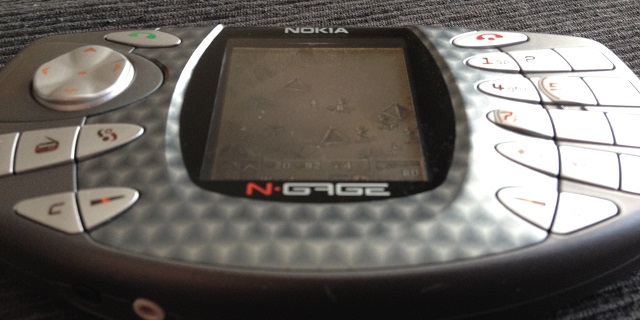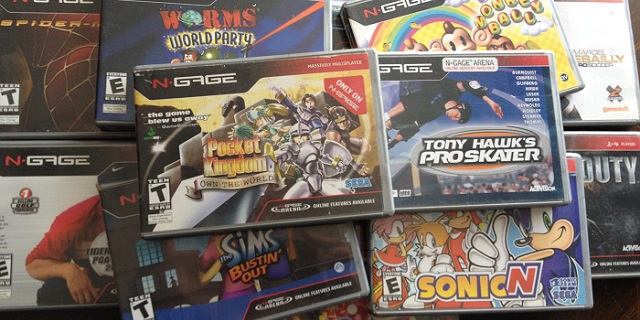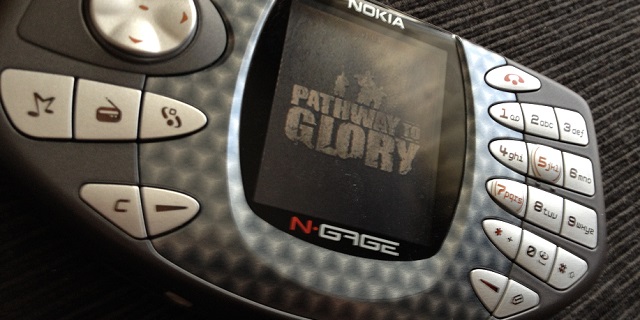
Being too far ahead of its time is a common way for a product to fail, especially in the technology business. This is often the most tragic kind of failure, because it is not the result of apathy or cynicism, but just a great idea that the rest of the tech world couldn’t quite support yet. This was the undoing of Nokia’s N-Gage phone. It is a concept that we take as commonplace and even expected in today’s mobile space, but nevertheless garners a great deal of ridicule in retrospect: that a cell phone can run games as well as its handheld competitors. While much of that ridicule was valid due to some baffling hardware design decisions, the N-Gage was a capable handheld that deserves a second look.
The System
The era of the Game Boy Advance was one of unprecedented dominance in the handheld space for Nintendo, even by its own high standards. With Sega bowing out of hardware altogether, SNK being bought out and nearly shut down by Aruze and Bandai being meek about bringing its handheld outside of its home country, Nintendo was quite literally the only game in town for some time. It wasn’t until November 2002 that Nokia announced it would be developing a competing gaming platform and integrating it with its cell phone line.
The phone was to be capable of music, video, photos, radio, email, Web browsing, third-party apps and, of course, games. All of this was thanks to Nokia’s Symbian OS, the dominant pseudo-smartphone operating system across the globe for most of the decade. On the hardware side, the phone featured a processor over six times as powerful as the Game Boy Advance, and was capable of rendering 3D on the level of most early DS games. Granted, much of the system’s processing power was used for the underlying OS, but the results are apparent in the graphical fidelity of the games.

The Story
However, the technical prowess of the system was mostly overlooked due to two big problems: hardware design and price. Nokia has always been known for unorthodox hardware design, and that doesn’t always pay off in its favor. Most relevant was the fact that Nokia didn’t have a good idea of what hardware design was necessary for a gaming handheld. Most infamous among the N-Gage’s shortcomings was the speaker and microphone placement on opposing ends of the device’s top edge, which led to games journalist Christian Nutt to coin the term “sidetalking”.
Second, the screen’s portrait orientation and small size made it less-than-ideal for most games, in which landscape mode is unquestionably dominant. Lastly, the cartridge slot was placed behind the battery. If you wanted to safely switch out games in an original model N-Gage, you would have to turn the system off, take off the battery cover, take out the battery, switch out the game, put it back together again and turn it back on. Thankfully, both of these issues were more or less rectified in the more compact and comfortable N-Gage QD. The N-Gage, despite being an all-in-one portable device, was still seen by consumers as far too expensive, with a hefty price tag weighing in at $300 at launch (once again, the QD softened the blow by launching at $100 on-contract).

The Possibilities
The sheer diversity of the N-Gage’s admittedly-small library is the platform’s most fascinating aspect. Many famous and respected franchises made an appearance on the phone, such as Crash Bandicoot, Tomb Raider, Tom Clancy, Sega Rally, Xanadu, Rayman, Sonic, King of Fighters, Red Faction and SSX. In addition, the system saw some franchises that rarely make handheld appearances, such as Civilization and The Elder Scrolls. Many of these were very faithful ports of their PlayStation or Saturn iterations; the powerful hardware was more than capable of a full console port.
Another important feature of the N-Gage as a gaming device was its inclusion of wireless multiplayer, using either Bluetooth for local play or cellular data networks for online multiplayer (via the N-Gage Arena service). In a time when the only thing resembling wireless multiplayer in portables was an obscure add-on for the Neo-Geo Pocket Color or limited functionality with the Game Boy Color’s IR port, the inclusion of both features on a handheld was mind-boggling. The N-Gage Arena online service saw use from titles such as Call of Duty, some Tom Clancy and EA Sports games, the online turn-based strategy game Pathway to Glory and the highly ambitious mobile MMORPG Pocket Kingdom. The N-Gage may have only received a total of 56 retail games, but the number of big-name franchises on display make it worth a look, if nothing else, for historical curiosity.

Just over a year after Nokia’s game platform launched, Nintendo released its next handheld, the DS, which borrowed many of the features that Nokia had been touting such as wireless multiplayer and online play. Nintendo’s momentum, as well as handheld newcomer Sony, drowned out any effort developers or publishers put into the N-Gage. The name “N-Gage” continued to be used by Nokia as a brand for its mobile gaming software efforts until around the time it began to abandon Symbian as a platform. For all the innovation it brought to handheld gaming, it was all for naught in a landscape that was not ready for it. It wouldn’t be until the advent of smartphone mobile application storefronts that the system’s goals would finally be embraced, but by then, the N-Gage hardware was but a fading memory.
If you are interested in seeing the half-steps between what we generally regard as gaming generations (such as the 3DO and Jaguar), or are a collector, then an N-Gage may be worth your while. Seeing surprisingly-accurate mobile incarnations of popular console games is quite fascinating from that perspective. There’s currently no good way to emulate the system, so unless you want to test your compatibility luck running games on an updated Symbian phone, getting an N-Gage is the only way to play them. If you do plan to get a system, though, I would highly recommend getting the N-Gage QD, as it fixes most of the problems that the original model had.
The N-Gage is one of those weird and wacky gaming curiosities that give you an experience you can’t get anywhere else. If you’re willing to take the plunge and see just what you missed, you may be pleasantly surprised by what Nokia’s machine had to offer.



















